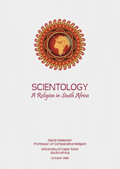Like any religion, the Church of Scientology conducts the formalized, repeatable, and extraordinary types of religious action that constitute ritual. Certainly, Scientology ritual includes ceremonies that recall the familiar practices of other religions. Ordained Scientology ministers perform the rites prescribed by the church for marriages, christenings (called namings in Scientology), and funerals. They also conduct regular Sunday services at Scientology places of worship. In the Church of Scientology, however, these rituals are not ends in themselves. They provide formal occasions for reinforcing the liberating knowledge of Scientology. As L. Ron Hubbard explained: “In a Scientology Church Service we do not use prayers, attitudes of piety, or threats of damnation. We use the facts, the truths, the understandings that have been discovered in the science of Scientology. We do not read from the Bible (or the Koran or the Torah or the Vedic Hymns, for that matter) and say to the people assembled there— ‘Now this is something you have got to believe.’ ”21 Again, the objective of Scientology is not to cultivate a devotional faith in a personal deity, a sacred text, or a religious practice; the objective is to achieve religious knowledge.
Ordained Scientology ministers perform the rites prescribed by the church for marriages, christenings (called namings in Scientology), and funerals. They also conduct regular Sunday services at Scientology places of worship.
On the path towards this liberating knowledge, the central ritual practice in the Church of Scientology is known as auditing. From the Latin audire, meaning to hear or listen, auditing is conducted in sessions that are held between a novice and an experienced auditor who listens carefully and monitors progress. The theory that supports this practice proposes that human beings have an analytical mind that processes information and a reactive mind that stores memories of all painful experiences from the past. Since many of those experiences were traumatic, the reactive mind bears deep traces, or psychological scars, that are referred to as engrams. These psychological obstacles have been implanted from previous life experiences, from prenatal experience, and from past lifetimes. Although engrams are embedded in the reactive mind, they can be brought to conscious awareness and cleared through auditing. As an aid in this process, an electronic meter—the electropsychometer, or E-Meter—is used in auditing sessions to measure the psychological charges associated with the reactive mind. In Scientology terms, the E-Meter is a religious artifact used in sessions of pastoral counselling. Through auditing, engrams can be released, resulting in a state of being that Scientologists refer to as Clear.
Although it draws upon certain psychodynamic theories and methods, auditing can be understood as a ritual practice that combines features of religious healing, confession, and meditation.
First, auditing can be understood as ritual healing. As historian of religions Jonathan Z. Smith once observed, “a religion that does not heal cannot long survive.”22 In the modern world, religious traditions have given over the responsibility for healing the body and the mind to a scientific medical profession. Like other “new religious movements,” however, the Church of Scientology has worked to reclaim this religious function of healing. In particular, Scientology practice is directed toward achieving a spiritual healing that can have positive consequences for the health and well-being of the mind and body.
Second, auditing has many of the characteristics of religious rituals of confession. As a familiar feature of Roman Catholic practice in which contrition, confession to a priest, and acts of penance form an important ritual cycle, confession also appears as a ritual in Buddhism. According to the Buddhist text of the Mahavagga, if anyone “remembers having committed a sin, and desires again to be pure, let him reveal the sin he committed, and when it has been revealed, all shall be well with him.”23 In the Buddhist ritual, therefore, a state of spiritual purity, which is similar in some respects to what Scientologists refer to as being Clear, requires recollecting memories of the past and revealing them through confession.
Third, the practice of auditing, especially in the advanced stages of “solo-auditing,” recalls more traditional religious rituals of meditation. In Buddhist practice, for example, ritual aids are often used to focus attention. The meditator might concentrate on a visual design, a sacred tone, or an enigmatic riddle to achieve a new clarity of awareness. Frequently, meditation is monitored by a teacher who observes the progress of novices.
In addition to auditing, Scientology provides training as an educational programme that recovers the religious dimension of the activity of study. In many religious traditions, the intensive study of sacred texts is an important religious ritual. In the Jewish yeshiva, for example, the study of sacred texts under the supervision of a Talmudic master is explicitly understood as a religious activity with all the characteristics of ritual. Similarly, Scientology training involves an intensive engagement with sacred texts, under ministerial supervision, as a significant religious activity. Just as the Church of Scientology has tried to recover the religious function of healing, it has also worked to restore the religious significance of the disciplined activity of study.





























